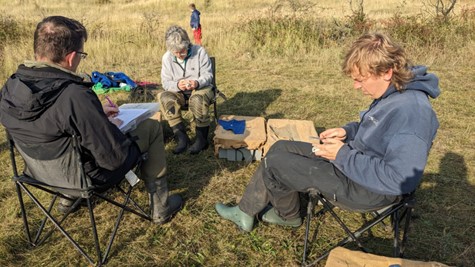Friday 4 October
On the morning tide, recces were carried out at Gedney and on the east side around Heacham. At Gedney, Bar-tailed Godwit came onto the pools as the tide came up, however they were not concentrated in a particular area of the pool and so this wasn’t a great option for cannon-netting. However, a couple of hundred Sanderling were found on Heacham South beach, roosting over the high tide, where the profile of the beach is such that a flat area was present – this seemed to be where the birds were choosing to roost. This seemed like the better option, and so it was decided for nets to be set there that evening after the tide for a catch on Saturday morning.
Two small-mesh nets were set in a groove to be fired over the preferred roosting area of the Sanderling, with some grot. These were left overnight for an early arrival the next morning.
Saturday 5 October
The team was on site at Heacham South at 06:30 in preparation for the 08:30 tide, with an aim to catch at around 07:30. Shortly after decoys were placed, birds began to arrive close to the catching area – although beyond the maximum extent markers, as the tide was yet to push them properly up the beach. The birds were fairly mobile and spread along a large area of beach. While dog walkers to the north did a good job of bringing birds down the beach (to a total of 2–300), there was limited concentration of birds in the catching area. Some twinkling was done to move the Sanderling from the north and south; although, due to the remarkable tameness of many of the birds, it did feel more like herding!
Difficulties did not end once the birds were in the catching area. Generally, after each flight, the birds would all land close to the shore and then run up the beach, bringing birds into safety and over the net. This made it difficult to take a worthwhile catch, as, by the time enough birds were in the catching area, there would be birds in safety. A final bit of twinkling by Nigel to bring birds down the beach caused a final flight, after which Sanderling landed in front of the nets. There was a brief window of opportunity after this to take the catch before birds moved back up into safety, which Lucy took, firing the more northern of the pair of nets.
This gave a lovely sample of just under 90 Sanderling, alongside two Oystercatcher and a Turnstone. This was a great size of catch for the small team and allowed a great training opportunity. A training processing team was set up, and Louis and Lys were each able to double wing a sample of 30 Sanderling.
| Species | New | Retrap | Total |
| Sanderling | 82 | 5 | 87 |
| Oystercatcher | 2 | 0 | 2 |
| Turnstone | 1 | 0 | 1 |
| Totals | 85 | 5 | 90 |


In the afternoon, nets were set on the outer pool at Terrington for a mist-netting session on the evening tide. In total, eight ecotone nets were set in a line of five and a line of three. The lines were roughly parallel to each other, set on the outer edge of the pool perpendicular to the wind.
In the afternoon, nets were set on the outer pool at Terrington for a mist-netting session on the evening tide. In total, eight ecotone nets were set in a line of five and a line of three. The lines were roughly parallel to each other, set on the outer edge of the pool perpendicular to the wind.
The team arrived at the marsh at around 19:00 and went straight out to the pool. On arrival at the nets, there was already a large number of birds caught (probably c.70, including around 15 Black-tailed Godwit) even before tapes were on, and despite the relatively light conditions. These were extracted and taken off, then tapes were put on and a few more rounds of birds extracted. In total, 150 birds were caught – despite the fairly high total, it was a relaxed catch and we never felt under pressure due to the number of birds.
The highlight of the catch was probably the 21 Black-tailed Godwits caught, of which most were colour-marked (unfortunately, we ran out of combinations and had to leave the last few with metal rings only). Additionally, four Grey Plover including a retrap of a colour-marked bird were caught, which were added to the flagged population. Overall, it was a very pleasant evening with a nice selection of species.
| Species | New | Retrap | Total |
| Redshank | 75 | 3 | 78 |
| Dunlin | 27 | 1 | 28 |
| Black-tailed Godwit | 21 | 0 | 21 |
| Turnstone | 17 | 0 | 17 |
| Grey Plover | 3 | 1 | 4 |
| Bar-tailed Godwit | 2 | 0 | 2 |
| Totals | 145 | 5 | 150 |
Sunday 6 October
Early on Sunday morning, Michèle, Nick, Lys and Lynne went out to Freiston to attempt to resight Redshank. Unfortunately, this was not possible as only six Redshank came onto the pools – they were, however, treated to incredible views of a Kingfisher which perched just in front of the hide.
The rest of the team rose later and split into a resighting group and a chore group; Tanya and Claudia went up the east side searching for Turnstone, while Louis went with Rob to Snettisham where Louis resighted while Rob walked the dog. 11 Turnstone were resighted, as well as 10 Curlew. Among the Curlew were a headstarted female from the 2021 cohort, as well as a bird which was seen in Finland in a previous summer back on The Wash for another winter. Many of these resightings were the first of the winter for each respective individual.
Back at the base house, a number of useful jobs were completed; data sorting, cleaning and greasing cannons, checking and replacing base plates, cutting new mist net material and more. A hearty breakfast / lunch of pancakes was kindly prepared by Sam and enjoyed by all before departure throughout the afternoon.
Overall, it was a very successful weekend with almost 250 birds caught, alongside numerous resightings.
Trip ringing totals
| Species | New | Retrap | Total |
| Sanderling | 82 | 5 | 87 |
| Redshank | 75 | 3 | 78 |
| Dunlin | 27 | 1 | 28 |
| Black-tailed Godwit | 21 | 0 | 21 |
| Turnstone | 18 | 0 | 17 |
| Grey Plover | 3 | 1 | 4 |
| Bar-tailed Godwit | 2 | 0 | 2 |
| Oystercatcher | 1 | 0 | 1 |
| Totals | 230 | 10 | 240 |
Resighting totals
| Species | Sightings | Individuals |
| Curlew* | 10 | 105 |
| Turnstone | 37 | 29 |
*Plus one headstarted bird.
Thanks to Louis Driver for writing this report. Cover image by Lynne Lambert.

